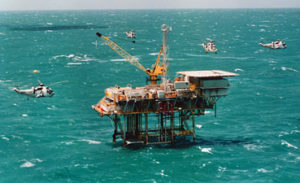The following is a summary of a paper by Captain Marcus Peake RAN Ret’d, Webmaster of the Fleet Air Arm Association of Australia (FAAAA). The full story, published in August 2016, is available on the FAAAA website at https://www.faaaa.asn.au/snippets-history-operation-bursa/. This summary was compiled by Midshipman Lloyd Skinner, RAN.

Located in Bass Strait are several offshore oil facilities that are a significant economic and energy asset for Australia. Between the late 1970s and 1980s, thinking emerged within the contemporary Federal Government that such installations were vulnerable due to the “real and potentially highly dangerous” threat of a terrorist attack[i]. Given the national importance of the facilities, the government proceeded to have naval and air units carry out surveillance tasks in protection of Australian oil rigs, under Operation BURSA.
Previously, on 21 September 1978, the Intelligence and Security Committee of Cabinet established a ‘hard line’ policy toward responding to the terrorist threat. Terrorism had pivoted itself into the national dialogue with the bombing near the Sydney Hilton Hotel on 13 February 1978. This was the impetus for the inclusion of a Counter Terrorist (CT) capability within the Special Air Service Regiment (SASR) on 31 August 1978, known as the Tactical Assault Group (TAG). The responsibilities of TAG included the recovery of hostages, property, buildings and installations as well as neutralisation or capture of terrorist groups. These directly coincided with the need to respond to the threat in the Bass Strait. Strategically, due the architecture of oil platforms, Special Forces would have to be propelled onto the installation via aircraft. The Wessex 31Bs of the HC 723 Squadron were chosen and a specialised team of the SASR, codenamed Nullah, was developed to work with the unit.
Despite the age of the Wessex helicopter, introduced into the Navy in 1962, with the anti-submarine warfare equipment removed the cabin was spacious enough to house six SAS troopers, designating it the appropriate utility aircraft for the operation. The aircrew were trained in close flying formations during daytime and night. Similarly, TAG operators refined their fast response tactical manoeuvres and close quarter combat training. To retake the installation from the terrorist group in the most effective manner, the maximum number of soldiers had to be deployed into the oil rig in the shortest period of time. As such, aircraft would hover above the oil rig, and troopers would fast rope onto the deck, where they would begin the recovery of hostages and the entire facility. Navy clearance divers were also embedded within TAG and provided an underwater assault complimentary to what the SAS provided from the air. Attack and Fremantle Class Patrol Boats continually undertook Bass Strait Oil Rig Surveillance (BSORS) from 28 June 1980 and support for TAG and Wessex aircraft during the myriad exercises conducted in the Strait. The first detachment of Wessex helicopters to East Sale occurred during October 1980 and following initial workup, full exercises commenced in April 1981.

The Wessex was the best available aircraft for the operation; however, there were several serviceability and maintenance issues that posed challenges to the success of the operation. A principal problem was the lack of navigational and positioning equipment, which made close formation night flying extremely hazardous. The risk of collision was high and the lack of any specialised equipment necessitated ‘heath robinson’ solutions such as the use of cyalume sticks for visual positioning. Astonishingly, there were no accidents during the night assaults, although one aircraft crashed during a daylight resupply mission with the loss of two lives.
By February 1984 723 Squadron had too many aircraft types and increasing responsibilities, and the CT tasking became too difficult to manage. Consequently, Wessex were transferred to the newly commissioned 816 Squadron and by mid-1985 the Sea King Mk 50s of 817 Squadron were preparing to assume the CT role. This was fully handed over in late 1986 when 816 Squadron was decommissioned. The low number of Sea King airframes and conflicting operational requirements were a constant strain on 817 Squadron, however, and the role was eventually handed to the Army in December of 1989.
Retrospectively, BURSA successfully fulfilled a tasking that was borne from serious Government concern for the vulnerability of the national assets. The capacity to meet the requirement with old aircraft and little specialised equipment demonstrated the professionalism and determination of ADF personnel involved. The conclusion of the Navy’s tasking on 01 December 1989 saw limited material achievement; however, many insights into tactics and strategy were gained and would inform CT operations in the future.




